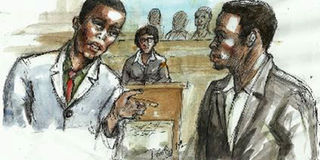Cross-examination of the doctor during Kiruhura murder cases

What you need to know:
- False: According to reports, it was clear that the doctor had not carried out a complete postmortem examination and he had not dissected the bodies to see any internal injuries.
The doctor who carried out the postmortem examinations on six people, who were killed in Kiruhura District on the night of August 16, 2013 was forced to apologise in court when the defense lawyers raised an objection, when the State tendered in some postmortem reports as exhibits.
In one case, the doctor wrote the word “Rushere” in the place where he should have signed and he also forwarded the report to a police officer called “Rushere”.
The doctor told court that he wrote these in error and owned his mistake. The State submitted that it was a curable defect that would not cause any injustice to the case.
On another postmortem report, the doctor forwarded the report to himself. The defence lawyers told court that forensic science is an exact science which allows no room for such errors of this nature and court was requested to take judicial notice that the doctor had admitted he made errors.
The report was thereafter admitted as exhibits when the doctor confirmed that he indeed had made them. Court cautioned the doctor to ensure that any other document he authored was properly signed. To say these were errors of oversight is an understatement; these were reckless and careless errors that the lawyer called gross professional negligence.
One of the defence lawyers took the doctor through the importance of forensic medicine in law enforcement and justice delivery, the two types of postmortems, clinical and forensic, and the importance of a postmortem in establishing the cause of death. To the lawyer, the cause of death must be established beyond reasonable doubt and must exclude other causes of death, including natural causes.
The lawyer also pointed to the importance of a postmortem in establishing the time of death, in tracing and collecting evidence and determining the nature of a weapon used in the commission of an offence.
And a properly done postmortem examination can go as far as establishing the possible height, strength of a suspect and whether the suspect was right handed or left handed, particularly in relation to the nature of the injuries caused.
Indeed a postmortem well done, should be used with a scientific accuracy to reconstruct the events surrounding the offence.
To illustrate his point, the lawyer asked the doctor to look at one of his reports in which the victim was 1.74 metres tall and sustained three cuts on the head.
The lawyer further asked the doctor if a person half that height could possibly inflict those injuries, to which the doctor replied that it was possible depending on the nature of the weapon.
The doctor on the six postmortem reports indicated that the first postmortem examination was carried out at 11:20am and the last one was performed at 12:10pm.
To the lawyer, the six postmortem examinations were performed in less than one hour, with each ranging between five minutes to fifteen minutes.
The doctor’s explanation was that what he indicated in the form was the time he sat down to document the postmortem findings.
However, the lawyer would have none of that. The lawyer reminded him of the 10-year-experience of testifying in court that the doctor had boasted of and asked him to read what is written on the postmortem form immediately.
The time and date of arrival of the body; clearly it is the date and examination of examining the body and not the time of writing the report.
It was clear that the doctor had not carried out a complete postmortem examination; he had not dissected the bodies at all and could therefore not see any the internal injuries that the victims sustained.
The doctor documented dimensions of various injuries, some of which indicated that the wounds were quite deep.
The external examination of these injuries was, however, not enough to indicate the exact nature of the internal injuries. The nature of these injuries should have made it inevitable for the doctor to dissect the bodies.
The doctor confessed that such wounds would cause major internal injuries, which he, unfortunately, did not document.
To the defence lawyer, one of the purposes of a medico-legal autopsy is to establish beyond reasonable doubt the cause of death.
The defence lawyers, therefore, challenged the doctor on the conclusion that excessive bleeding was the cause of death in most of these cases as the doctor had not visited the scene of crime and therefore could not have ascertain how much blood the victims had lost.
The doctor confessed that he did not open and dissect the body and could not tell how pale the internal organs were, one way of determining excessive bleeding.
The doctor, however, told court that the nature of the injuries can be used to calculate the blood loss.
According to the expert, the best method of determining blood loss in a victim is by determining the depth of the injury, the size of the injury, the location of the injury and any associated organ injuries.
But without opening the head of one of the victims, the doctor had the audacity to state that the cause of death was closed head injury.




